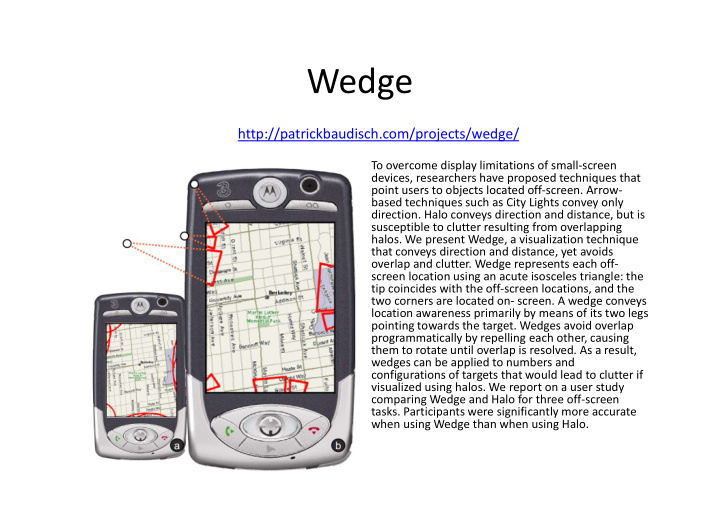



Wedge http://patrickbaudisch.com/projects/wedge/ To overcome display limitations of small-screen devices, researchers have proposed techniques that point users to objects located off-screen. Arrow- based techniques such as City Lights convey only direction. Halo conveys direction and distance, but is susceptible to clutter resulting from overlapping halos. We present Wedge, a visualization technique that conveys direction and distance, yet avoids overlap and clutter. Wedge represents each off- screen location using an acute isosceles triangle: the tip coincides with the off-screen locations, and the two corners are located on- screen. A wedge conveys location awareness primarily by means of its two legs pointing towards the target. Wedges avoid overlap programmatically by repelling each other, causing them to rotate until overlap is resolved. As a result, wedges can be applied to numbers and configurations of targets that would lead to clutter if visualized using halos. We report on a user study comparing Wedge and Halo for three off-screen tasks. Participants were significantly more accurate when using Wedge than when using Halo.
Related Work • Edgeradar • Arrows • City lights • Halo
edgeradar 3 [Gustafson 07]
simple arrows 4 [Tecmo Bowl 87]
scaled and stretched arrows 5 [Burigat 06]
city lights “space-efficient fisheye technique” 6 [Mackinlay 03]
halo 7 [Baudisch 03]
Related Work • Edgeradar • Arrows • City lights • Halo • Problem with halo: – Clutter and corners
9
Evaluation • 18 subjects, with 2 removed because of high error rate – Note: This is OK … • Three tasks: – Locate: Click off-screen where you think the target is – Avoid: Traffic jams are indicated and you need to click the hospital furthest from traffic jams – Closest: Click on halo/wedge corresponding to closest off-screen location
Hypotheses • Wedge is more accurate • Larger improvement in dense condition • Larger improvement in corners – (no hypothesis about task time) 11
Results • No significant difference in task time • Participants were significantly more accurate when using the wedge Side Side Corner Halo Halo 60 60 Wedge Wedge 40 40 20 20 0 0 Dense Sparse Dense Sparse Dense Sparse 12
Locate Task As can be seen from Figure 11 larger errors were seen in corner trials (mean 51 pixels) than in side trials (mean 30 pixels). There were also larger errors in dense Side Corner configurations (mean 43) than sparse configurations (mean 38). The overall difference between visualizations was about Halo 60 10 pixels (Halo mean 45.3 pixels; Wedge Wedge mean 35.6 pixels). In addition, there was a significant 40 interaction between Visualization and Position (F1,15=15.36, p=0.001). As shown in Figure 11, the difference between 20 visualization types is considerably larger in corners than on the sides of the screen, which supports our hypothesis that the 0 reduced space in corners causes additional Dense Sparse Dense Sparse problems for Halo interpretation. There was no interaction between Visualization and Density (F1,15=0.67, p=0.43).
Additional Results Avoid: Closest Figure 13 shows error rates for the Figure 15 shows error rates for the different visualizations, densities, and different visualizations, densities, and positions. A 2x2x2 ANOVA did not show positions. A 2x2x2 ANOVA showed any effects of Visualization (F1,15=2.55, significant main effects of Position p=0.13), Position (F1,15=2.38, p=0.14), (F1,15=76.6, p<0.001) ), but not of or Density (F1,15=0.58, p=0.46). In Visualization (F1,15=1.24, p=0.28) or addition, there were no interactions Density (F1,15=0.12, p=0.73). There was between any factors. a significant interaction between Density and Position (F1,15=7.33, A 2x2x2 ANOVA showed no effects of p=0.016), but no interactions with any of the three factors on task Visualization. completion time (Visualization F1,15=0.18, p=0.68; Density F1,15=2.09, A 2x2x2 ANOVA showed significant p=0.17; Position F1,15=1.58, p=0.23), main effects of Position (F1,15=5.24, and no interactions between any p=0.037), but did not show effects of factors. Visualization (F1,15=0.10, p=0.76) or Density (F1,15=2.89, p=0.11). There was, however, a significant interaction between Visualization and Density (F1,15=6.60, p=0.021).
Additional Results Comments made during the trial suggested reasons for the advantages for Wedge over Halo. One user said, “I found that when the rings overlap it is almost impossible to tell which is the right ring. Wedges just seem natural.” And another stated, “overlapping rings made it very confusing at times. Directional wedges helped a lot, and they also seem to take up less space. More information meant less thinking with the wedges.” Participant’s comments also provided some insight into the reasons why Halo was preferred for the Closest task – that the difference between distant and close off-screen objects was easier to determine with Halo, since there is a large visual difference in this case. One participant stated that, “the sizes of the arcs did not require too much calculation or thinking to spot the smallest ring.”
Meta-Level Comments: Experimental Papers • A lot of techniques + evaluation • Predictable outline: – Problems with existing techniques – Rationale for new design – Evaluation of new design • Usually two or three tasks – Discussion and implications
Your thoughts?
My Problem with Wedge • Read the paper • For visualization, ONLY LOCATE had significant differences, and ONLY FOR ERROR • But 2 participants were removed for high error … • And note that, IMO, visualization is only significant for corners
Second consideration • Closest completion time was the only other area of significance, and only for interactions • A 2x2x2 ANOVA showed significant main effects of Position (F1,15=5.24, p=0.037), but did not show effects of Visualization (F1,15=0.10, p=0.76) or Density (F1,15=2.89, p=0.11). There was, however, a significant interaction between Visualization and Density (F1,15=6.60, p=0.021). • Problem: – Why not explore this interaction as they do for errors in Locate?
Concerning because
Another problem • Graphs – Kept on showing dense-sparse for Halo-Wedge even when no interactions – Particular problem in locate because of interaction between density and position, but not visualization:
Recommend
More recommend